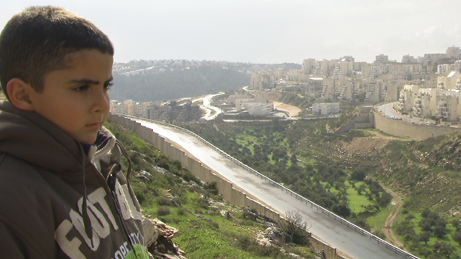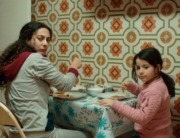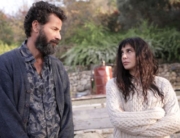
Director Emad Burnat's son Gibreel looks over at the Israeli settlements (Kino Lorber Films)
It’s not unusual for the father of a newborn to get a camera and take a lot of photographs as he grows up. But photographer Emad Burnat’s fourth son, Gibreel, is born in 2005, just when the Israeli government’s controversial separation barrier reaches their village of Bil’in in the middle of the West Bank, and Gibreel’s childhood will be marked by the shadows it casts over his family and community. This unusual blending of the personal and the political moves intensely, if narrowly, behind the shouting and shooting on the TV news.
Burnat introduces the background of recent Palestine-Israel relations in terms of his sons’ experiences, from his oldest, born in 1995 during the hopeful Oslo negotiations, to his third son, born in a hospital full of the wounded. He films celebrants at weddings and festivals, but then their same musical instruments are turned to political purposes in noisy weekly demonstrations against the wall’s construction.
Burnat provides a close up look at the actual disruptive process of taking over village property and constructing the huge concrete barrier (26-feet tall, surrounded by a 200-foot exclusion zone) that the Israelis claim has reduced terrorist attacks since it first started going up in 2002. In the process, bulldozers uproot olive trees that have been tended by the same families for generations and provide their livelihood. While attention is on the differences between the villagers, the ultra-Orthodox settlers, and the Israeli soldiers, his footage very visually exposes the physical proximity of the Palestinians’ orchards thrust against the looming density of modern high-rise settlements Israelis built on the other side of the wall.
His first camera is wrecked by the soldiers, and the damage to each subsequent camera— by an aggressive settler, in a car crash, from bullets—becomes a framing device for following his friends and family members as each reacts to the volatile situation. His filming at a neighborhood hangout where they vent through years of frustrations provides an intimate look behind the usual images of violent arrests, bloody wounds, and wailing funerals. He stresses their efforts to keep their protests nonviolent, including through a lawsuit, in the face of verbal and physical provocations from the army and the settlers.
Putting individual faces and personalities onto victims and activists, his narrative mostly focuses on the actions of two of his friends and the reactions of the authorities, interrupted by his own injuries behind his cameras. But the impact on his youngest son leaves a disturbing impression for the next generation. Gibreel’s first words include “wall” and “army,” and when one of his father’s avuncular friends becomes “a martyred brother,” Gibreel talks about killing a soldier with a knife. At five years old, he may have already been radicalized. Last year, his father tried to introduce something brighter into his life— a trip to Tel Aviv allows for the boy’s first look at the ocean. Burnat documents that with his sixth camera.
Other documentaries have provided some of the wider context missing here, Julia Bacha’s Budrus (2009) included the international politics around nonviolent protests against the wall, and This Is My Land… Hebron revealed the vicious prejudices of ultra-Orthodox settlers. More unclear is the role of Israeli co-director Guy Davidi and other Israeli peace activists, whether in providing cameras or shaping the story for structure and dramatic effect. In their joint personal statement, they ambiguously describe Davidi as “a kind of Cyrano de Bergerac,” so it’s not clear if Burnat’s narration is in all of his own words or how much was written for him. Regardless, the power of seeing their point of view outweighs these concerns.






Leave A Comment